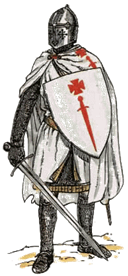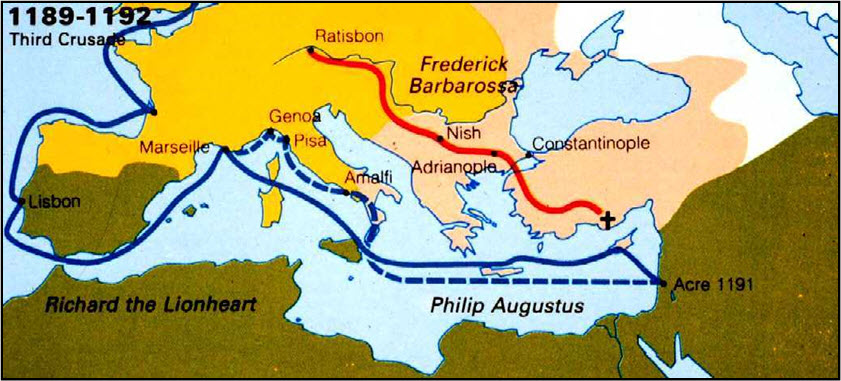


THE THIRD CRUSADE 1189 (R1)
Including:
The Teutonic
Knights

xxxxxFollowing the capture of Jerusalem by Saladin in 1187 (H2), Pope Gregory VIII launched the third Crusade. Among those who answered the call in 1189 were the kings of France, Germany and England. It looked promising but, unfortunately, national rivalries were to get in the way. The German expedition went overland to Asia Minor, but broke up when their emperor, the aged Frederick Barbarossa, was drowned crossing a river. The French and English went by sea but, having taken Acre, the two kings -
xxxxxThe massive assault upon the Holy Land by Saladin, the Sultan of Egypt, culminating in the capture of Jerusalem in October 1187 (H2), was met with anger and concern in the courts of Europe. The pope, Urban III, died on hearing the news -
xxxxxThe German expedition chose to go over land and made good progress, but on reaching Asia Minor the aged Emperor was drowned while crossing a river. Without his firm leadership the army disintegrated. Some men deserted, others were killed, and some were captured and sold into slavery. Meanwhile, the English and French went by sea to Acre where Richard played a prominent part in the capture of the city. At this stage, however, the bitter differences between the French and English kings came to a head. As rivals in Europe, both were suspicious of each other and, whilst Richard was an enthusiastic crusader, the French king was more anxious about the state of his homeland than the fate of the Holy Land. He decided to take his army back to France.
 xxxxxRichard the Lionheart soldiered on and, having defeated the Muslims at Arsuf and captured the port of Jaffa, he marched to within sight of the Holy City. But further conquest proved impossible and discretion proved the better part of valour. Realising that he had no hope of recapturing Jerusalem, he came to terms with Saladin -
xxxxxRichard the Lionheart soldiered on and, having defeated the Muslims at Arsuf and captured the port of Jaffa, he marched to within sight of the Holy City. But further conquest proved impossible and discretion proved the better part of valour. Realising that he had no hope of recapturing Jerusalem, he came to terms with Saladin -
xxxxxAnd this crusade had another important "spin-
xxxxxThe Third Crusade had all the hallmarks of success, made up as it was of three European armies and led by their monarchs. But despite its size and the quality of its leadership, national rivalries got in the way. As a result there was never a common purpose, a sense of unity, or a combined strategy. All three would have been necessary to take on and defeat a Muslim army which was so large, so committed, and so well led. Thus, despite further crusades, the Holy City of Jerusalem remained in the hands of the "infidel" until the First World War over 700 years later. And, as we shall see, the next Crusade, launched in 1202 (JO), did not go further than Constantinople, and ended up by sacking that city!
 xxxxAs mentioned earlier (1113 H1), it was during this crusade that the religious military order of the Teutonic Knights was formed. It was established at Acre in 1190 by the German Crusaders, its full title being the Teutonic Knights of Saint Mary's Hospital at Jerusalem. Recognised by the pope in 1199, membership was restricted to German nobles, but followed the same format as that of the Knights Templars and the Knights of Saint John of Jerusalem. Despite its origin, much of its work was carried out in eastern Europe, mainly due to the influence of its grand master Hermann von Salza. In this area, the Order carved out for itself a sizeable piece of real estate, but as we shall see, its forces were defeated at the Battle of Tannenburg in 1410 (H4), and never recovered their military power. Eventually, the movement was dissolved by Napoleon in 1809, but was fully restored in 1929 as a charitable and nursing order -
xxxxAs mentioned earlier (1113 H1), it was during this crusade that the religious military order of the Teutonic Knights was formed. It was established at Acre in 1190 by the German Crusaders, its full title being the Teutonic Knights of Saint Mary's Hospital at Jerusalem. Recognised by the pope in 1199, membership was restricted to German nobles, but followed the same format as that of the Knights Templars and the Knights of Saint John of Jerusalem. Despite its origin, much of its work was carried out in eastern Europe, mainly due to the influence of its grand master Hermann von Salza. In this area, the Order carved out for itself a sizeable piece of real estate, but as we shall see, its forces were defeated at the Battle of Tannenburg in 1410 (H4), and never recovered their military power. Eventually, the movement was dissolved by Napoleon in 1809, but was fully restored in 1929 as a charitable and nursing order -
Acknowledgement
Map (Third Crusade): licensed under Creative Commons -
R1-



